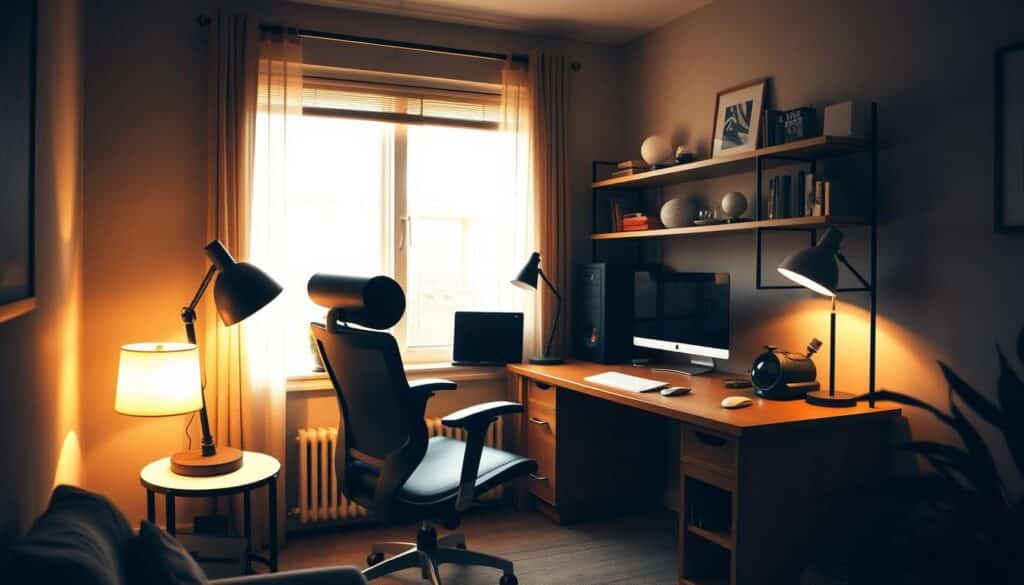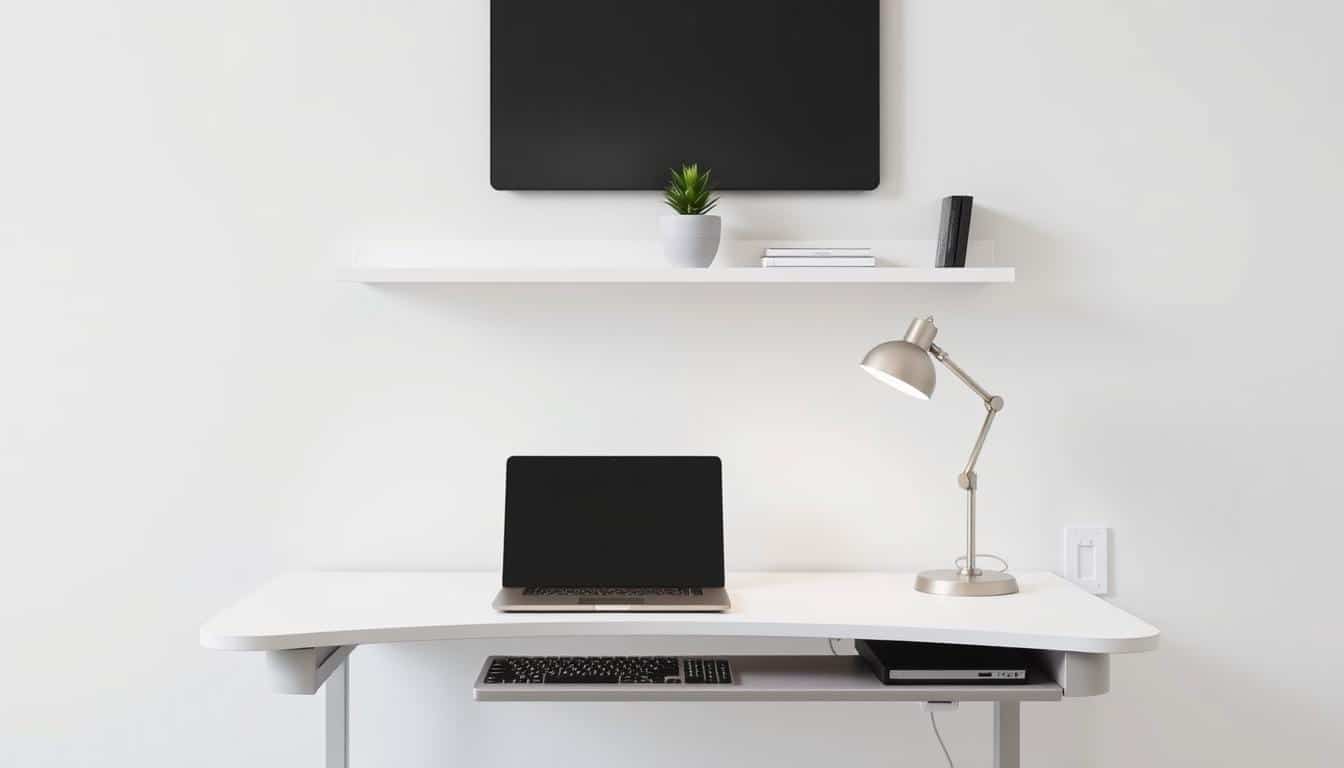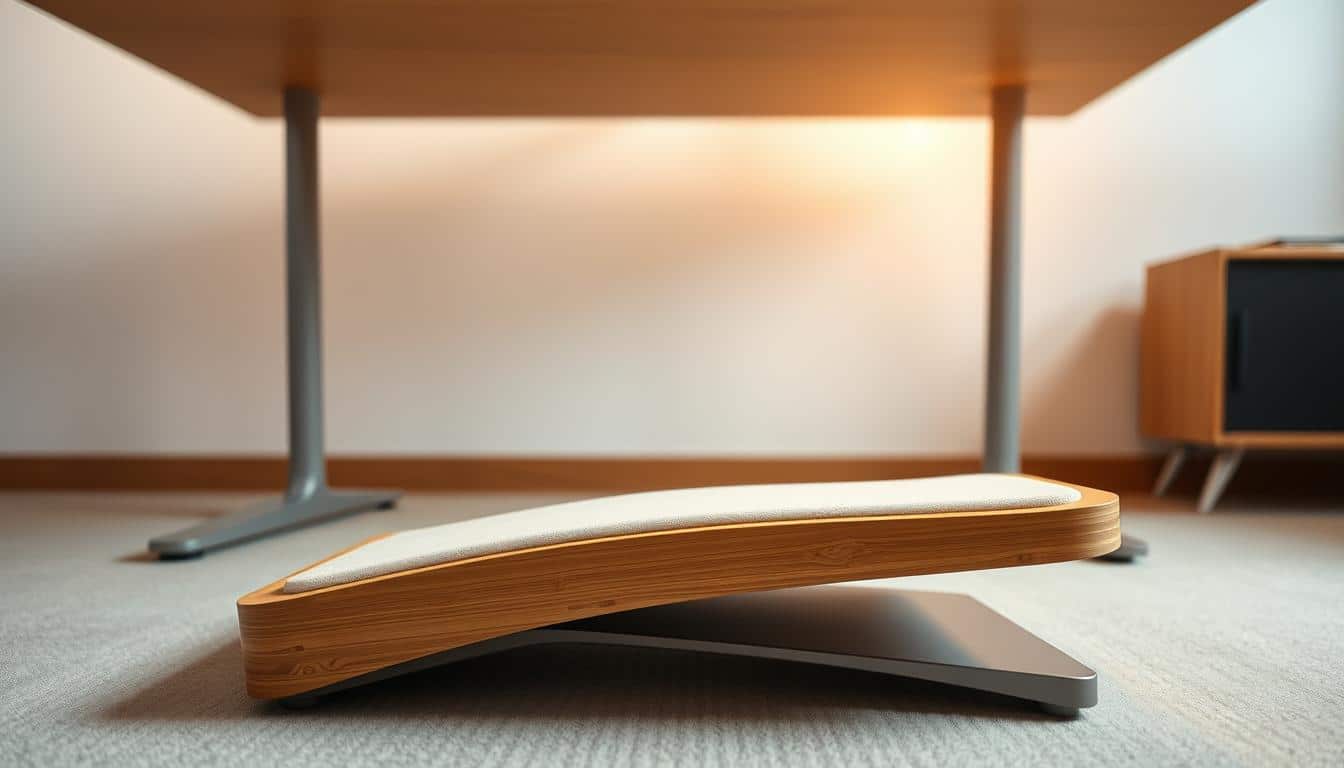In today’s work-from-home world, having a good home office setup is key. But dark corners can make it hard to stay motivated and focused. Good lighting is super important to make a space where you can work well and feel good.
This article will show you the best lights for dark spots in your home office. It focuses on choices that boost mood and help you do better, especially on video calls. With the right lighting, even the darkest corner can become a perfect spot for work and creativity.
Understanding the Importance of Lighting in Your Home Office
Good lighting in your home office makes a big difference in work and health. It cuts down eye strain and fatigue from staring at screens. Having the right light helps you focus better, making you more efficient at work.
Use both sunlight and lamps to light up your workspace well. Sunlight refreshes your surroundings. Artificial lights keep things bright when it gets dark. Think about what lights you use and how you arrange your office. These choices affect how light spreads in your space.

Key Benefits of Natural Light for Productivity
Natural light plays a big role in boosting productivity at work. It makes people feel better and more energized. Workplaces with plenty of sunlight help everyone work better and stay sharp all day.
Adding windows and skylights helps use sunlight fully. By placing desks near these sources, the workspace feels alive. Tools that cut down on glare also make sure people are comfortable while working.
Avoiding setting up desks against plain walls makes the office look better. Using plants and natural touches improves the vibe, which is good for mental health and harmony. A welcoming workspace sparks creativity and makes people more productive.
The Role of Artificial Light in Dark Spaces
In spots where the sun’s rays don’t reach, artificial light is key. It changes gloomy areas into places where work gets done. Each kind of artificial light has its job. Ambient light brightens up the whole room. Task lighting shines on spots where you read or work closely. Then, accent lighting makes art or design features stand out.
Putting lights in the right places can get rid of shadows and ease strong contrasts. These issues can slow down work. Mixing ambient, task, and accent lighting well makes any space work-ready. It’s good for both team video calls and working by yourself. Knowing how to layer lights helps make work areas welcoming and effective.
Best Lighting for Dark Home Office Corner
To make a dark office corner inviting and productive, the right lighting is key. Know the right types to make the space both look and work better. Using ambient, task, and accent lighting together improves both light and style.
Types of Lighting to Consider
For a dark home office corner, think about these lighting types:
- Ambient Lighting: It lights up the whole area, important for seeing everything clearly.
- Task Lighting: This goes over work spots, giving focused light so you don’t strain your eyes.
- Accent Lighting: Adds beauty to the space, making it better looking and more pleasant.
Optimal Placement of Lighting Fixtures
Putting lights in the right spots changes a workspace. Here’s how to avoid shadows and light up well:
- Place lamps by the desk but away from where you sit.
- Wall-mounted lights reflect off surfaces, lightening up dark corners.
- Floor lamps that adjust let you shine light exactly where it’s needed.
Layering Your Lighting for Maximum Effect
To spruce up a dark home office corner, mix different types of lights. Using ambient, task, and accent lighting will really make the space shine. This mix helps the room adjust to any task or mood during the day.
Ambient lighting sets the overall glow of the room. Task lighting focuses on work spots, helping you concentrate. Accent lighting, though, points out special decor, adding charm and detail. Mixing these lights turns a plain office into a welcoming, useful space.
Try adding dimmer switches and adjustable lights for balance. These let you change the light to fit any activity, from hard work to relaxation. By smartly layering lights, you make your workspace both nice to look at and great for getting things done.
Choosing the Right Light Fixtures
Choosing the right light fixtures makes your home office both work-friendly and cozy. It’s important to know the difference between task and ambient lighting. Task lighting brightens specific work areas, while ambient lighting gives the room a gentle glow. By mixing these types, your workspace will feel both comfortable and easy to work in.
Task Lighting vs. Ambient Lighting
When picking out lights, it’s key to find ones that offer both task and ambient lighting. Desk lamps offer focused light for work, reducing eye strain. Meanwhile, ambient lights, like chandeliers, spread soft light throughout the room. This balance ensures your office has the right light for work and relaxation.
Accent Lighting to Enhance the Space
Accent lighting adds beauty to your home office. It brings attention to art, plants, or unique architectural features. With options like wall sconces and track lights, accent lighting adds layers to your office’s lighting. Properly used, it makes your workspace more engaging and visually appealing.
Tips for Eliminating Glare and Shadows
Getting the lighting right in your home office is key. Glare and shadows can make it hard to focus and lower your work output. Use indirect lighting to beat glare. Lights that reflect off walls give off a gentle glow. This makes working for long hours more comfy.
Try using anti-glare screens too. They protect your eyes from strong reflections on your computer screen. This makes your workspace easier to see. Choose lighting that softens intense light, like lamps with frosted covers, to cut down on shadows.
Where you put your lights is very important. Don’t have your desk right under bright overhead lights. Instead, arrange your space so that soft light, whether it’s natural or not, fills the room. This makes the light better overall and your space more welcoming, helping you work more smoothly.
Utilizing Mirrors and Light Colors to Amplify Brightness
Making a dark home office brighter is easy with the right design touches. Mirrors and light colors are key for this. They change your workspace’s feel, making it seem bigger and more welcoming.
Strategic Placement of Mirrors
Putting mirrors in the right spots can make light bounce around your home office. Here’s what to do:
- Place mirrors opposite windows to capture and reflect natural light.
- Use mirrors to create depth, making the space appear larger and brighter.
- Incorporate decorative mirrors that reflect light fixtures to enhance artificial lighting effects.
Choosing Light Colors and Surfaces
Choosing light colors for walls and surfaces can really brighten up a home office. Here are some tips:
- Opt for whites or soft pastels that reflect light, creating an airy atmosphere.
- Use glossy finishes on surfaces, as they can amplify light and add a modern touch.
- Incorporate light-colored furniture and decor elements to complement the overall brightness.
Lighting Solutions for Windowless Offices
Working in offices without windows comes with unique challenges. Making sure there is enough light is critical in these areas. A top solution for windowless offices is to use full-spectrum LED lights. They mimic natural daylight. This method lessens eye strain and makes the space brighter.
Using smart lighting systems is another great way to improve workspace design. These systems let you change light levels and colors during the day. This is perfect for different tasks and how you like to work.
It’s also smart to use wall-mounted sconces and other fixtures that save space. They help spread light around without taking up much room. Picking the right lighting can make windowless offices feel less closed off and more energetic.
Choosing Energy-Efficient Lighting Options
Finding the best lighting for your home office is key. It should boost productivity and keep you comfy. LED lights stand out because they save electricity and provide great light.
Benefits of LED Lighting
LEDs offer many advantages, which is why people love them. Let’s look at a few important benefits:
- Longevity: LEDs can shine for up to 25,000 hours, which means you rarely need to replace them.
- Energy Efficiency: LED lights use up to 80% less energy compared to old-school bulbs. This lowers your electric bill.
- Sustainability in Lighting: Choosing LEDs helps the planet by cutting down on waste and energy use.
- Versatility: You can find LEDs in many shapes, sizes, and colors. This lets you get creative with your office lighting.
- Programmable Options: Some LED lights can be set to different modes. This makes them both useful and cozy.
Using LED lights matches today’s design trends and shows you care about the environment. Switching to these lights makes your home office better for both work and the planet.
Conclusion
Making your home office bright is key to working well. Combining natural and man-made light is crucial. It makes the space inviting and helps you do better.
We looked at how to make your workspace brighter with different lights and where to put them. Following these tips can change a dull space into a bright one. It lifts your spirits and helps you work more efficiently.
Think about how you can improve your light situation at home. By focusing on good lighting, you can create an office that boosts your productivity and health.



